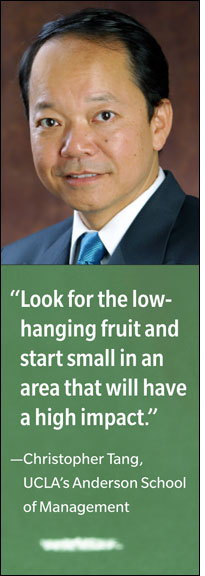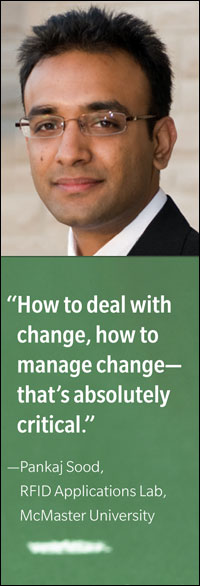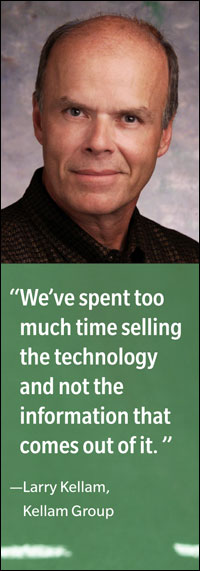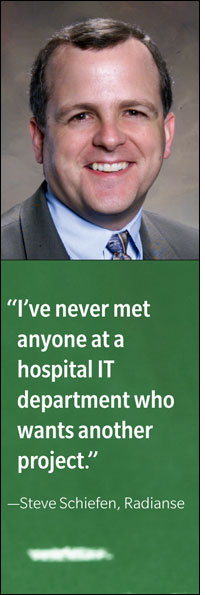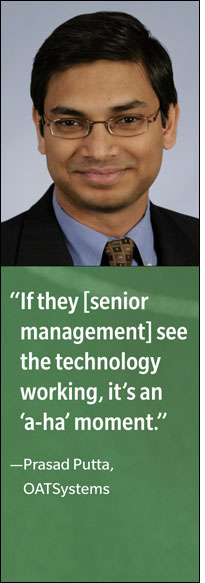Apr 01, 2010PinnacleHealth, a health-care system in central Pennsylvania, had an ongoing problem: Wheelchairs in its Harrisburg Hospital were never where they were supposed to be. Not only did this mean patients often had lengthy waits before being transported, but there was also an unfortunate ripple effect: Discharges were delayed, rooms couldn't be cleaned promptly and readied for incoming patients, and security guards, nurses and other employees frequently had to stop what they were doing to search for an available wheelchair.
George Morley, the organization's director of biomedical engineering, saw a way to solve the problem. Harrisburg Hospital was using an RFID-based real-time locating system (RTLS) from Radianse to track patients, and Morley thought it could be expanded to track wheelchairs, as well as IV pumps, crash carts, stethoscopes and other critical equipment. But despite the hospital's successful deployment of the patient-tracking system, Morley's initial funding request was turned down. Hospital management wasn't convinced the investment was worthwhile. "Some people thought RFID was just a toy," Morley says.
Undeterred, he spent the next several months continuing to accumulate data on how much money and time was being lost due to missing equipment. He also spent hours talking to other staff members and listening to their stories on the subject. Then, armed with a compelling business case, he presented his proposal to hospital executives, describing the problems and explaining the potential benefits of tagging and tracking medical gear. This time, he secured funding for the project.
The RTLS, deployed in 2006, delivered a return on investment within a year. Since then, PinnacleHealth has expanded the system, which now tracks more than 6,000 assets—everything from ultrasound transducers to vacuum cleaners—at the organization's Harrisburg and Community General hospitals. The asset-tracking system is proving its worth, Morley says. In the first year alone, PinnacleHealth saved $900,000 on equipment costs, because the number of items that disappeared decreased dramatically. In addition, productivity has improved, because staff members no longer waste time hunting for wheelchairs, stethoscopes and other items.
Morley's experience is not unusual. RFID Journal often hears from frustrated end users working in a wide range of industries who have a business problem they know RFID can solve. Yet, they can't get their projects green-lighted by upper management. Sometimes they're told the company can't afford to fund the project. Others are rebuffed by concerns that deploying a new technology is too risky. And many suspect that those in charge just don't want to disturb the status quo or risk their jobs on a project that might not work. "It only takes one person in the chain of command to say no to kill a project," says one executive at a major consumer packaged goods company whose RFID proposals have met with resistance.
But clearly, given the number of RFID projects that are going forward, some end users who lobby for change are successful. To learn how they overcame the obstacles that threatened to thwart approval of their RFID pitches—whether for a pilot project or expansion of a system already in place—we spoke with more than a dozen people involved with successful RFID projects, including end users, RFID systems integrators, consultants and technology vendors. While every organization is unique, we found there are some common strategies for marshaling support and securing funds for RFID deployments.
You may have identified several ways RFID could improve operations or processes in your organization, but to get a pilot project off the ground, you can't tackle them all at once. Pick your pain point and design a project that will address the problem and provide relatively quick payback. "The Big Bang approach is risky," says Christopher Tang, a professor of business administration at the University of California at Los Angeles' Anderson School of Management. "Look for the low-hanging fruit and start small in an area that will have a high impact. Learn from the experience and then roll it out to other departments."
In many organizations, it's easiest to win approval for those small-scale projects that provide rapid payback. "Focus on quick wins to help you develop success stories and build momentum," counsels Carlo K. Nizam, head of value chain visibility and auto-ID at Airbus. "Sometimes you have to take the view that the fastest ROI might be the smartest thing. The visibility is fast, the momentum is fast and the results are fast. That helps with the overall perception shift needed to get future funding."
Airbus, for example, developed a three-phase program for deploying RFID companywide, to improve business processes and provide real-time automated visibility. Starting with phase one, the aircraft manufacturer proved the business benefits of an RFID application before introducing new pilots and deployments. It took the same approach for phase two and in its planning for phase three.
Similarly, at PinnacleHealth, Morley started out by tagging and tracking a limited number of items at its Harrisburg Hospital. As staff members embraced the idea of having location information available at their fingertips—and the benefits became evident—the company expanded the system to track more assets, and then deployed the RTLS at its Community General Hospital.
2. Build a Rock-Solid Business Case
To convince people in your company that an RFID project is worthwhile, you have to articulate how the investment of time, money and other resources will improve operations. You have to build a bulletproof business case that supports the organization's business strategy. Look at existing processes, document where there's room for improvement and calculate how the changes will impact the company's operations and bottom line.
"Properly understanding the scope of the problem is key," says Pankaj Sood, founder of the RFID Applications Lab at McMaster University in Hamilton, Ontario. "That should drive everything." Whether it's an inability to keep track of supplies, a chronic lag in manufacturing cycle time or a need to get retail goods on the shelves faster, businesses must understand the problems and their root causes, and then develop a plan to address those issues.
"There's no substitute for talking to the employees who are directly involved in the areas where RFID may be introduced," says Toby Rush, CEO of Rush Tracking Systems, a systems integrator and RFID solutions provider. "You do 'a day in the life.' You ask manufacturing operators how they do their jobs and how errors could be avoided."
Several veterans of successful RFID deployments agree that the earlier you draw people into the planning, the better the chances of success. Airbus' Nizam says involving people from every part of the company impacted by a potential RFID deployment as early as possible can ensure that the project will support the organization's goals and strategy. The cross-functional steering committee Airbus organized when it first began to consider RFID—Nizam describes it as a "mini-Airbus"—articulated the needs of all the company's stakeholders and set priorities for the project.
Early input from people throughout the organization also helps identify any changes in processes, schedules or responsibilities that may be required. Planning for and managing those organizational changes is something some companies give short shrift to when implementing a project, and that can create barriers to acceptance. "How to deal with change, how to manage change—that's absolutely critical," Sood says.
Some companies bring in consultants to help evaluate and document processes and determine if a project would deliver value. Then, with a well-designed pilot, you can test the assumptions about how RFID will reduce costs and improve efficiencies.
A pilot that's limited in scope—say, one that will cost less than $10,000—will generally require fewer levels of approval than a full-scale deployment, which can cost many times more and will likely face a rigorous financial review from upper management, says Bryon Blackburn, principal of Blackburn Global, a consultancy that focuses on RFID and location technologies. As companies struggle to recover from the recession, expectations for a solid and swift ROI from capital investments have never been higher. "We live in a competitive global economy—you really have to have a return on your investment," Blackburn says. "If you can't justify it within a year, you won't get your project through."
For American Apparel, a Los Angeles-based clothing manufacturer and retailer, the ROI on an RFID pilot in one store to improve inventory accuracy and stocking of merchandise on the sales floor led to expansion of the solution to other locations. The company is now RFID-tagging individual garments in at least 10 stores and also plans to use the technology to prevent theft. (RFID Journal has developed a "Fashion Retail ROI Calculator" that enables apparel and footwear retailers to estimate how much RFID would cost based on their store layout, and how much return they can expect to get on the investment. It's available for free at www.rfidjournal.com.)
3. Manage Risk
In this climate of economic uncertainty, many businesses have limited appetite for the risks associated with new technologies. Restricting the scope of your RFID project is one way to manage risk. Some companies are asking RFID vendors and system integrators to shoulder part of the burden through guarantees and strict service-level agreements. Radianse, for example, is helping some health-care customers get their projects approved by guaranteeing an ROI, says the company's CEO, Steve Schiefen. Radianse will assess the customer's business processes, develop a project plan and calculate an expected ROI. If the company doesn't achieve the agreed-on payback within 18 months, Schiefen says, Radianse will make up the difference.
Another tactic for managing risk is leasing the RFID tags and interrogators, which minimizes the capital outlay. For instance, when the University of California San Diego (USCD) Medical Center deployed an RTLS to track medical equipment at its Thornton Hospital, it leased the technology from Awarepoint. The fact that there was no up-front capital cost made it easier to get upper management approval, says Scott Sullivan, the medical center's business manager for perioperative services.
Other companies are asking vendors to structure deals so they share the costs—and the financial benefits—of their RFID deployments. "We've been asked by clients to do a risk-reward sharing model," says Diana Hage, CEO of RFID Global Solution, a software and systems integrator. Hage says her company is exploring how such an arrangement might work and is "actively in discussions with clients about it."
Some projects get derailed when supporters pitch to upper management by emphasizing the underlying technology rather than the benefits it can deliver to the company. While you want to identify the project as an RFID solution that can bring visibility to critical business activities—analysts say "RFID visibility" is now a meaningful term even in executive suites—don't get bogged down explaining tags, interrogators and other system details.
"Most senior managers don't care about the technology—it's the information they care about, how you use the information to increase sales or cut costs," says Kellam, who was formerly the director of business-to-business supply-chain innovation at Procter & Gamble. "We've spent too much time selling the technology and not the information that comes out of it."
When trying to garner support for an RFID deployment, discussions should be framed in terms of the impact the project will have on furthering the organization's goals, such as streamlining operations or improving customer service. "You've got to treat RFID as a process-enabling technology," Airbus' Nizam says. "RFID isn't a final destination, but one of many vehicles to get you to that destination."
A message that communicates a clear picture of how the visibility the technology enables will be used to make better decisions, speed up production, reduce mistakes on the factory floor or improve the company's bottom line has the best chance of resonating with senior management, Kellam says.
You'll get the most value from the information collected by an RFID system when you integrate it with the organization's back-end systems, such as procurement or enterprise resource planning. But initially, that may not be the best approach, due to the risk, expense and amount of change involved.
A hurdle for any technology project is the potential strain it could place on an already stretched-thin IT department. Adding responsibility for the design, rollout and support of another system can set off opposition. To circumvent that problem, many people advise designing a pilot or early-stage deployment that minimizes the burden on IT employees.
"I've never met anyone at a hospital IT department who wants another project," Radianse's Shiefen says. "They're swamped." He suggests representatives from IT should be involved in the projects but shouldn't be expected to lead them.
"Engage IT early, but take a light touch on IT," Rush recommends. When working with customers, his company looks for projects that initially require a minimum amount of integration with enterprise systems. This limits the complexity and narrows the role the IT organization has to play to get the project off the ground.
At the USCD Medical Center, the fact that the data from the RTLS isn't integrated with other information systems helped speed up approval and deployment. "Minimal IT involvement was a big plus," Sullivan says.
Still, organizations must carefully weigh the tradeoff that comes with the cautious approach, says RFID Global Solution's Hage. Narrowing project scope can improve your chances of getting approval, but it also can limit the long-term upside. "It's an artful dance between what organizations will accept and taking the investment to the most innovative level," she says. Ultimately, to unlock the maximum value of the RFID investment, more integration with enterprise systems will likely be required.
The familiar Expository Writing 101 refrain—"show it, don't tell it"—can also be applied when trying to take an RFID project from pilot to full deployment. Demonstrating the technology in action is a powerful tool that can be used to persuade upper management of its value.
Airbus has opened a 300-square-meter (about 3,200- square-foot) industrial showroom on an actual aircraft final assembly line. "All the new processes and technology that we use today in our projects across the company—and are developing for tomorrow—are demonstrated, so company executives, customers and supply-chain partners can see how the systems work and how it can help them," Nizam says. "It's very useful. Seeing is believing. You're convincing people not by PowerPoint, but by hard, tangible examples set in a real industrial environment."
For more than a year, OATSystems (a division of Checkpoint Systems) has been putting together "mobile innovation centers" for its customers to show off pilot projects to senior managers and other executives. Whether in a retail store or on a manufacturing plant floor, the company typically spends a couple of weeks on site demonstrating the technology. "We might do 20 walkthroughs over two weeks," says Prasad Putta, OATSystems' VP and general manager, adding that once people see the technology in action, they start brainstorming new ways it can be applied. "If they see the technology working, it's an 'a-ha' moment for them—they can get their heads around it," he says. "If you want to go from a pilot to a full-fledged deployment, you have to make sure you show the value to all the stakeholders."
For executives at one large Midwest manufacturing company, which declined to be identified, seeing the technology in action was transformational. The firm had deployed RFID at several sites, and some managers were pushing for an expanded role for tracking technologies based on the benefits that resulted from being able to pinpoint the location of parts and products. "We spent a lot of time bringing project-by-project metrics to senior management, but that wasn't grabbing them," says a manager involved with the company's RFID efforts.
So the managers tried a different tactic. They arranged for several executives to visit one of the company's manufacturing facilities, where they could see for themselves how the technology was being used and hear directly from plant workers about the benefits. "That's what turned the corner," says the manager. "Then it became real for them." After the visit, the executives agreed to expand the role of tracking technology across the company. The enterprisewide use of RFID is expected to transform the company's operations, bringing efficiencies and other long-term improvements.
"This is our future," the manager states. "We believe RFID gives us a competitive advantage. It's changing the way we do business."



